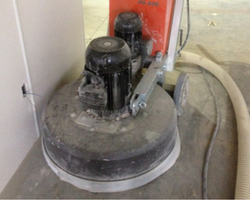
The best method for stripping sealers is often debated. The best method to use really depends on various factors. Before you decide which method to use to remove the sealer it is important to know what kind of sealer you are stripping. Not all sealers are alike, so this makes a difference when choosing how to remove it. Thicker sealers such as epoxies and polyurethanes perform better, but will take more time to strip than thinner sealers, such as acrylics, take.
There are two general ways to strip sealers. One way is chemically and the other is mechanically. Chemical strippers use chemicals to break down the polymer make up of a sealer. The sealer is permanently damaged by the chemicals, and is typically turned into sludge. With mechanical stripping, the sealer is blasted or grinded off with the use of equipment. Some common mechanical methods include shot blasting, bead blasting, grinding, and scarifying the sealer. It’s important to make sure that the substrate below the sealer is not damaged when using the mechanical method. A softer shot or beads, such as seed hulls or finely ground corn husks should be used at this level to help prevent substrate damage.
Using a chemical stripper is by far the most effective and popular method for removing sealers, especially with decorative concrete because the profile and the color must be maintained. There has been a lot of change for chemical strippers in recent years. The push for less harsh and environmentally friendly chemicals has resulted in new chemical strippers that are less harsh on the environment. Natural strippers, such as soy and citrus-based strippers. use natural esters and oils to break down sealers. Natural strippers have a very low impact on the environment, but they do take more time to work. The harsher methylene chloride chemical strippers work at a much faster rate. These chemical strippers have been popular for years to strip paints and other coatings, but they potentially hazardous and volatile to the environment and the applicator. So if you are not tight on time, then considering an environmentally friendly stripper.
The chemical stripping process requires time and keeping the stripper wet, which keeps it active. Chemical strippers must be kept active to work. Typically, these strippers come in a gel form, which keeps them active for a longer period of time. With natural strippers, much more time is required and keeping them wet is critical. A good technique for keeping strippers moist is to use a damp cotton sheet to cover the stripper to keep it active. The sheet not only keeps the stripper moist, but it also helps to absorb the dissolved sealer making removal easier. You may need to repeat this process a few times depending on the surface, type of sealer, and type of stripper. The most difficult type of surface to strip is definitely stamped concrete due to it’s texture and grooves.
The surface will need to be cleaned thoroughly after the sealer has dissolved completely, even if the sheet was used to remove the sealer. A high pressure system with warm water should be used to remove the sealer sludge, followed by soap and water to clean any remaining residue. Rinse with clean water and ensure that the surface is completely dry before adding any new sealer to the surface.
There are so many creative and custom options for finishing concrete, but first and foremost important is the concrete itself. At Custom Concrete Creations we have state of the art equipment and a properly trained team with years of experience. Custom Concrete Creations is a premier contractor serving the Omaha area as well at the Midwest. Give us a call or send us an email for your custom concrete finishing needs today!
